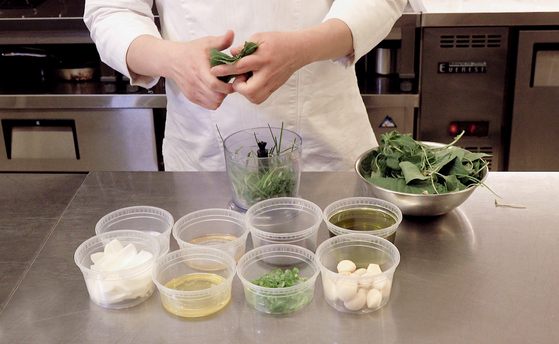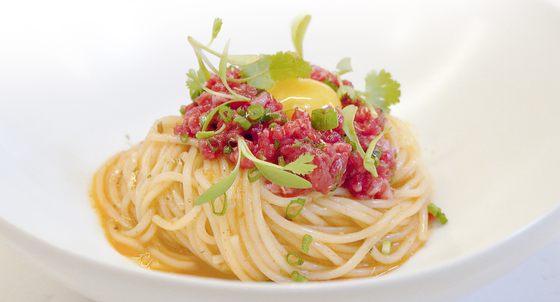[Taste of Hansik] Hanwoo Bibim Guksu
Guksu (noodles) is a carb to be reckoned with in Korean cuisine. Similar to how Koreans eat rice with savory banchan (assorted small dishes) for their everyday meal at home, they often do the same with noodles.One of the most common ways to eat plain noodles in Korea is to mix a bowl with gochujang, essentially making the basis for a dish called bibim guksu. Bibim in Korean means mixing.
Although bibim guksu is widely recognized as noodles with gochujang, noodles mixed with any sauce can technically be called bibim guksu. If you mix noodles with perilla seed oil, then it’s perilla seed oil bibim guksu. If you mix noodles with doenjang (fermented soybean paste) then it is doenjang bibim guksu.
The name of the dish can also be changed according to any additional vegetables or meat you put in it. If you add kimchi, it's kimchi bibim guksu, and if you add raw meat, then it’s yukhoe bibim guksu. Yukhoe means raw meat in Korean.
Many think of guksu as something easy to make at home. Somyeon (thin noodles) or jungmyeon (middle-thickness noodles) are often used to make bibim guksu, and can easily be found at any Korean supermarket in the country or overseas. Making the sauce is easy and quick, and any vegetables like cabbage or cucumber, or chunks of meat, raw or cooked, can be added as per one's preference.
Today, the Korea JoongAng Daily will introduce a bibim guksu variety made with spring vegetables and gochujang. The olive oil and gochujang sauce will give your dish a mild kick of spiciness while still enhancing the taste of the spring vegetables. This version will be made using raw hanwoo (Korean beef).

Ingredients:
Spring vegetable sauce:
100 grams spring vegetables, 20 grams coriander leaves, 20 grams rice vinegar, 2 cheongnyang peppers, 10 grams sliced garlic, 60 grams sliced onion, a pinch of cayenne pepper, 280 grams extra virgin olive oil, 10 grams fish sauce, 20 grams soy sauce, 20 grams sesame oil
Sour gochujang paste:
100 grams gochujang , 5 grams sesame seed oil , 50 grams sugar , 25 grams rice vinegar, 10 grams soy sauce
Beef:
100 grams beef loin , 8 grams extra virgin olive oil , 20 grams chive
Additional items:
one pinch of sancho powder , 5 grams salt , 56 grams apricot syrup

Instructions:
Wash all the vegetables and drain well.
Add all ingredients for the spring vegetable sauce in a blender and mix. For best results, refrigerate the sauce for one day.
Mix all the ingredients for the gochujang sauce until the sugar is well incorporated.
Mix together 100 grams of the spring vegetable sauce and 42 grams of the gochujang sauce, then add apricot syrup, sancho powder and salt to taste, and set aside.
Dice the raw beef into small pieces and mix it well with olive oil, chives, and salt, and set aside.
Cook the noodles according to the package instructions. Once cooked, rinse the noodles in ice water and drain.
Mix the noodles with the sauce, then put the chopped beef on top. You can add an egg yolk on top and decorate with any leftover greens. Drizzle some sesame oil on top.
BYLEESUN-MIN[summerlee@joongang.co.kr]










with the Korea JoongAng Daily
To write comments, please log in to one of the accounts.
Standards Board Policy (0/250자)